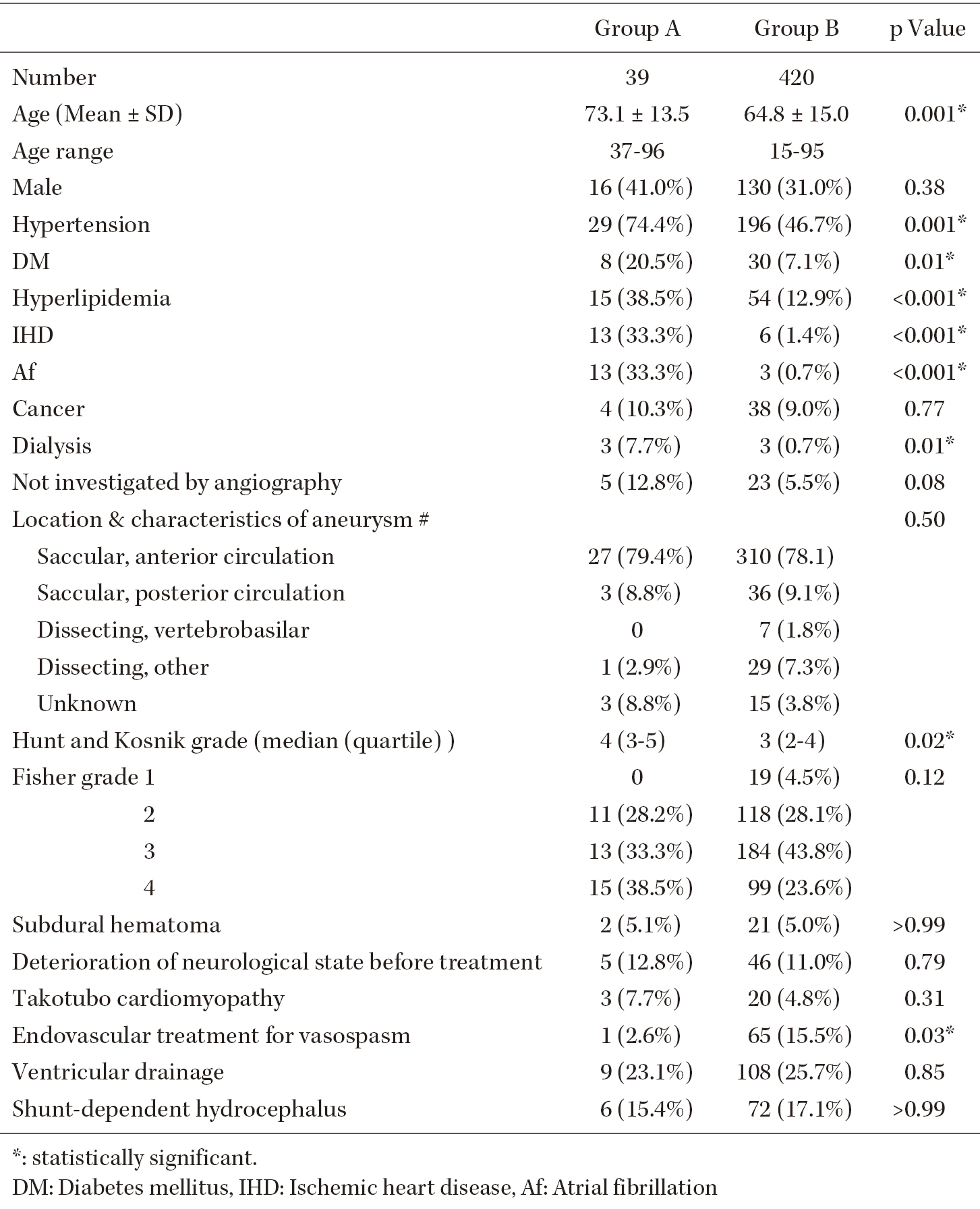- 著者
- Masaaki UNO Kenji YAGI Hiroyuki TAKAI Satoshi HIRAI Yukari MINAMI-OGAWA Yoshifumi TAO Yoshihiro SUNADA Shunji MATSUBARA
- 出版者
- The Japan Neurosurgical Society
- 雑誌
- Neurologia medico-chirurgica (ISSN:04708105)
- 巻号頁・発行日
- pp.2022-0122, (Released:2022-10-13)
- 参考文献数
- 19
With the aging of the population, the number of people taking antithrombotic drugs is increasing. Few reports have described the clinical presentation, treatment, and outcomes of nontraumatic subarachnoid hemorrhage (SAH) in patients with preceding antithrombotic therapy. This study included 459 patients with nontraumatic SAH who had been treated between April 2009 and May 2021. Overall, 39 of the 459 patients with aneurysmal SAH were on antithrombotic therapy before ictus (8.5%). Therefore, we classified patients into two groups: Group A (n = 39), patients with preceding antithrombotic therapy and Group B (n = 420), patients without preceding antithrombotic therapy. Hunt and Kosnik (H&K) grade on admission was significantly higher in Group A than in Group B (p = 0.02). Patients in Group A more frequently received endovascular treatment. The rate of endovascular therapy for symptomatic vasospasm after SAH was significantly lower in Group A (2.6%) than in Group B (15.5%; p = 0.03). The outcomes at 3 months after onset were significantly poorer in Group A patients than in Group B patients (p = 0.03). Patients with preceding antithrombotic drugs tended to be at greater risk of unfavorable outcomes, but this difference was not significant in the univariate analysis. In the multivariate analysis, patient age, H&K grade ≥4, and subdural hematoma remained as risk factors for poor outcomes; however, preceding use of antithrombotic drugs was not a significant risk factor.
- 著者
- Masaaki UNO Kenji YAGI Hiroyuki TAKAI Naoki OYAMA Yoshiki YAGITA Keita HAZAMA Hideki NAKATSUKA Shunji MATSUBARA
- 出版者
- The Japan Neurosurgical Society
- 雑誌
- Neurologia medico-chirurgica (ISSN:04708105)
- 巻号頁・発行日
- vol.61, no.2, pp.124-133, 2021 (Released:2021-02-15)
- 参考文献数
- 35
- 被引用文献数
- 4
We compared the rate of selective shunt and pattern of monitoring change between single and dual monitoring in patients undergoing carotid endarterectomy (CEA). A total of 121 patients underwent 128 consecutive CEA procedures. Excluding five procedures using internal shunts in a premeditated manner, we classified patients according to the monitoring: Group A (n = 72), patients with single somatosensory evoked potential (SSEP) monitoring; and Group B (n = 51), patients with dual SSEP and motor evoked potential (MEP). Among the 123 CEAs, an internal shunt was inserted in 12 procedures (9.8%) due to significant changes in monitoring (Group A 5.6%, Group B 15.7%, p = 0.07). The rate of shunt use was significantly higher in patients with the absence of contralateral proximal anterior cerebral artery (A1) on magnetic resonance angiography (MRA) than in patients with other types of MRA (p <0.001). Significant monitor changes were seen in 16 (12.5%) in both groups. In four of nine patients in Group B, SSEP and MEP changes were synchronized, and in the remaining five patients, a time lag was evident between SSEP and MEP changes. In conclusion, the rate of internal shunt use tended to be more frequent in patients with dual monitoring than in patients with single SSEP monitoring, but the difference was not significant. Contralateral A1 absence may predict the need for a shunt and care should be taken to monitor changes throughout the entire CEA procedure. Use of dual monitoring can capture ischemic changes due to the complementary relationship, and may reduce the rate of false-negative monitor changes during CEA.
